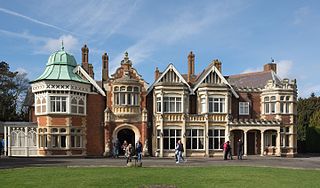
Bletchley Park is an English country house and estate in Bletchley, Milton Keynes (Buckinghamshire), that became the principal centre of Allied code-breaking during the Second World War. The mansion was constructed during the years following 1883 for the financier and politician Herbert Leon in the Victorian Gothic, Tudor and Dutch Baroque styles, on the site of older buildings of the same name.

Signals intelligence (SIGINT) is the act and field of intelligence-gathering by interception of signals, whether communications between people or from electronic signals not directly used in communication. Signals intelligence is a subset of intelligence collection management. As classified and sensitive information is usually encrypted, signals intelligence may necessarily involve cryptanalysis. Traffic analysis—the study of who is signaling to whom and in what quantity—is also used to integrate information, and it may complement cryptanalysis.

Ultra was the designation adopted by British military intelligence in June 1941 for wartime signals intelligence obtained by breaking high-level encrypted enemy radio and teleprinter communications at the Government Code and Cypher School (GC&CS) at Bletchley Park. Ultra eventually became the standard designation among the western Allies for all such intelligence. The name arose because the intelligence obtained was considered more important than that designated by the highest British security classification then used and so was regarded as being Ultra Secret. Several other cryptonyms had been used for such intelligence.
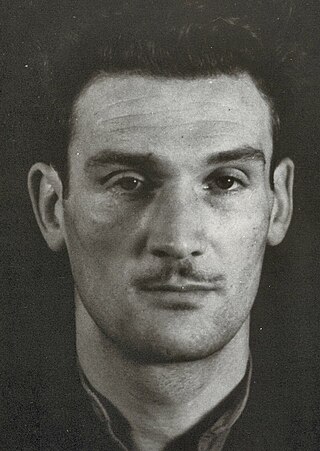
Edward Arnold Chapman was an English criminal and wartime spy. During the Second World War he offered his services to Nazi Germany as a spy and subsequently became a British double agent. His British Secret Service handlers codenamed him Agent Zigzag in acknowledgement of his erratic personal history.
Rupert William Simon Allason is a British former Conservative Party politician and author. He was the Member of Parliament (MP) for Torbay in Devon, from 1987 to 1997. He writes books and articles on the subject of espionage under the pen name Nigel West.
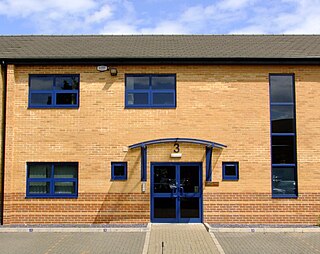
The Radio Society of Great Britain (RSGB) is the United Kingdom's recognised national society for amateur radio operators. The society was founded in 1913 as the London Wireless Club, making it one of the oldest organisations of its kind in the world. Through its work, it represents the interests of the UK's 80,000 licensed radio amateurs in the United Kingdom and certain dependent territories of the United Kingdom at the International Amateur Radio Union, acting as a medium for communication between the licensed operators and the UK government.
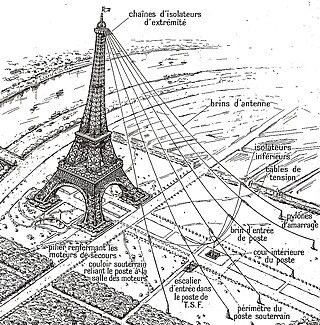
A radio listening station is a facility used for military reconnaissance, especially telecommunications reconnaissance by "intercepting" radio transmitter communications. In contrast to the original eavesdropping on an acoustic speech conversation, radio eavesdropping stations are used to eavesdrop on the information transmitted wirelessly using radio technology. For this purpose, highly sensitive radio receivers and suitable receiving antennas are used.
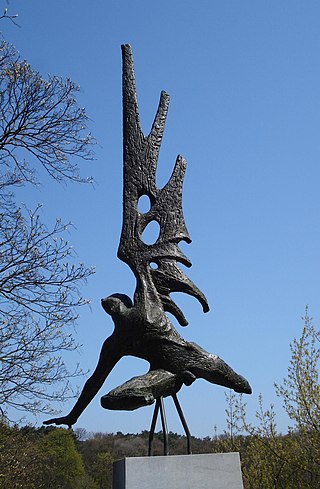
Englandspiel, or Operation North Pole, was a successful counterintelligence operation of the Abwehr from 1942 to 1944 during World War II. German counter-intelligence operatives, headed by Hermann Giskes of the Abwehr and Joseph Schreider of the Sicherheitsdienst (SD), captured Allied resistance agents operating in the Netherlands and used the agents' radios and codes to dupe the United Kingdom's clandestine organization, the Special Operations Executive (SOE), into continuing to infiltrate agents, weapons, and supplies into the Netherlands. The Germans captured nearly all the agents and weapons sent by the United Kingdom (Britain).
The "Y" service was a network of British signals intelligence collection sites, the Y-stations. The service was established during the First World War and used again during the Second World War. The sites were operated by a range of agencies including the Army, Navy and RAF, and the Foreign Office. The General Post Office and the Marconi Company provided some receiving stations, ashore and afloat. There were more than 600 receiving sets in use at Y-stations during the Second World War.
Before the development of radar and other electronics techniques, signals intelligence (SIGINT) and communications intelligence (COMINT) were essentially synonymous. Sir Francis Walsingham ran a postal interception bureau with some cryptanalytic capability during the reign of Elizabeth I, but the technology was only slightly less advanced than men with shotguns, during World War I, who jammed pigeon post communications and intercepted the messages carried.
The Wireless Experimental Centre (WEC) was one of two overseas outposts of Station X, Bletchley Park, the British signals analysis centre during World War II. The other outpost was the Far East Combined Bureau. Codebreakers Wilfred Noyce and Maurice Allen broke the Japanese Army's Water Transport Code here in 1943, the first high-level Japanese Army code broken. John Tiltman broke prewar Russian and Japanese codes at Simla and Abbottabad.
Funkspiel was a German term describing a technique of transmission of controlled information over a captured agent's radio so that the agent's parent service had no knowledge that the agent had turned and decided to work for the enemy. It was a standard technique in radio counterintelligence and was used throughout the world.
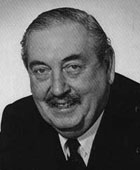
Brigadier Sir Richard Gambier-Parry, was a British military officer who served in both the army and the air force during World War I. He remained in military service post-war, but then entered into civilian life for more than a decade. In 1938, he was recruited by the head of the Secret Intelligence Service. Gambier-Parry led the Communications Section of the SIS during World War II, and assembled a clandestine wireless network that connected the United Kingdom with SIS agents in many countries, as well as helping to create the SIS resistance network in Britain. During the war, he was also recruited by the Director of British Naval Intelligence to serve as the radio consultant for Operation Tracer in Gibraltar. Post-war, he ran a network of secret listening stations.

Operation Bolívar was the codename for the German espionage in Latin America during World War II. It was under the operational control of Section D (4) from the Foreign Security Service (Ausland-SD), and was primarily concerned with the collection and transmission of clandestine information from Latin America to Europe. Overall, the Germans were successful in establishing a secret radio communications network from their control station in Argentina, as well as a courier system involving the use of Spanish merchant vessels for the shipment of paper-form intelligence.

The Secret Intelligence Service (SIS), commonly known as MI6, is the foreign intelligence service of the United Kingdom, tasked mainly with the covert overseas collection and analysis of human intelligence on foreign nationals in support of its Five Eyes partners. SIS is one of the British intelligence agencies and the Chief of the Secret Intelligence Service ("C") is directly accountable to the Foreign Secretary.
The Cipher Department of the High Command of the Wehrmacht was the Signal Intelligence Agency of the Supreme Command of the Armed Forces of the German Armed Forces before and during World War II. OKW/Chi, within the formal order of battle hierarchy OKW/WFsT/Ag WNV/Chi, dealt with the cryptanalysis and deciphering of enemy and neutral states' message traffic and security control of its own key processes and machinery, such as the rotor cipher ENIGMA machine. It was the successor to the former Chi bureau of the Reichswehr Ministry.
The Government of the United Kingdom maintains several intelligence agencies that deal with secret intelligence. These agencies are responsible for collecting, analysing and exploiting foreign and domestic intelligence, providing military intelligence, and performing espionage and counter-espionage. Their intelligence assessments contribute to the conduct of the foreign relations of the United Kingdom, maintaining the national security of the United Kingdom, military planning, public safety, and law enforcement in the United Kingdom. The four main agencies are the Secret Intelligence Service, the Security Service (MI5), the Government Communications Headquarters (GCHQ) and Defence Intelligence (DI). The agencies are organised under three government departments, the Foreign Office, the Home Office and the Ministry of Defence.

Nikolaus Ritter is best known as the Chief of Air Intelligence in the Abwehr who led spyrings in the United Kingdom and the United States from 1936 to 1941.

Whaddon Hall is a country house in Whaddon, Buckinghamshire. It is a Grade II listed building.
Funkabwehr, or Radio Defense Corps was a radio counterintelligence organization created in 1940 by Hans Kopp of the German Nazi Party High Command during World War II. It was the principal organization for the monitoring of illicit broadcasts. The formal name of the organization was the Funkabwehr des Oberkommandos der Wehrmacht (OKW/WNV/FU). Its most notable breakthrough occurred on 26 June 1941, when tracing teams at the Funkabwehr station at Zelenogradsk discovered the Rote Kapelle, an anti-Nazi resistance movement in Berlin and two Soviet espionage rings operating in German-occupied Europe and Switzerland during World War II. The Funkabwehr was dissolved on 30 April 1945.














